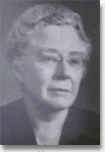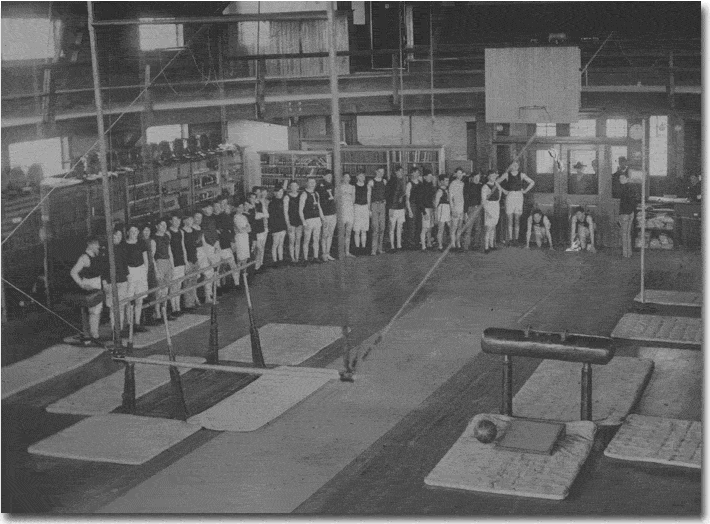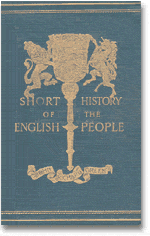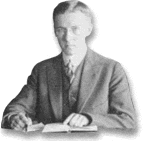Out of the Ashes: 1906 - 1908
The University of Idaho’s first professional librarian was hired in November 1905 — Mary Belle Sweet, 26, a graduate of the University of Illinois Library School. She was to remain in her job for 43 years.
Sweet was placed in charge of all the campus libraries, whose books were still largely uncataloged. Even the main library’s cataloging was rudimentary — for example, all history classified as “900”, with no further subdivisions.
But Sweet’s task of classifying the books was never completed — the library was destroyed in the March 1906 Administration Building fire. Because the library’s rooms were above a laboratory with volatile chemicals, the president forbade anyone from rushing in to retrieve any books, despite students’ protests. (Aside from a stuffed mountain goat and the university’s records, almost nothing was saved in the fire.)
The library was placed in the gymnasium, and Sweet began building a new collection, beginning with the 738 books that had been checked out at the time of the fire or had been in other buildings on campus. Of course, the library’s hours had to be curtailed, to accommodate the gym’s use as a sports facility, as Sweet later recounted in an interview:
On Monday morning after the fire, the library opened in the gymnasium. Linoleum was rolled down, tables set up, a few chairs placed around, and then at night, at 4 o’clock, it was turned over to the students for use as a gymnasium. They had constructed wooden bookcases on one side under the balcony, and if by chance a basketball went behind the bookcase, the boys went up the bookcase on the shelves, step-by-step, and down went the books. So there would be a heap of books on the floor after the games
Borrowing a typewriter for half-days, she wrote some 340 letters to authors, publishers and others asking for books and any other aid they could give. Response was good — the library received 1,300 books, 250 pamphlets, and $1,866 in funds. Nearby towns responded quickly — one of the larger contributions came from the people of St. Maries, who donated $132, as did many city fire </span>departments (within Moscow, the Neptune Hose Company #3 contributed $100, and the West End Hose company #4 sent $50).
The loss includes the entire library of about 12,000 volumes. As our loss is very heavy for so young an institution and state, we are asking for help, especially for the library.
The library needed essential works, and Sweet used the money to lay the foundations of a well-rounded collection. The gift from St. Maries, for example, was used to purchase historical works such as Gibbon’s History of the Decline and Fall of the Roman Empire, Cambridge Modern History and Green’s Short History of the English People. Other monies bought Webster’s New International Dictionary, Dictionary of National Biography and the Encyclopedia Britannica. And in her June 1907 annual report, Sweet asked president MacLean for funds:
In the past the University Library has contained few works of general culture. Many of our students come from isolated districts and have not had the advantage of access to an abundance of good literature. For this reason, our library should provide books of general interest more than do the libraries of universities which are situated in the older and more thickly populated states. I think it would be well if a definite part of the available funds could be set aside for the purchase of such books.
But the library was beginning to rebound through the efforts of Sweet and numerous benefactors, such as William E. Borah, and by this time contained 3,200 books and 7,000 U.S. Government documents, not to mention 101 periodical and 50 (mostly Idaho) newspaper subscriptions. History, literature and economics were the strongest areas, while sciences and languages remained weak.
During the 1906-07 academic year, the library loaned out 1,429 books — considerably more than during 1905-06. But the lending system was cumbersome, mainly because the library still lacked a full card catalog. Sweet asked for an assistant librarian to do the cataloging. And for 1907-08 the library’s budget jumped to $9,000 — an increase of $7,500 over the previous year — to help the library rebuild. Thus autumn 1907 represented the start of a new era for the library, which moved into Morrill Hall. Fourteen bookcases were placed in the main reading room, 13 in the documents section, and eight in the hallway. Although crowded, the reading room could accommodate seven tables and 80 readers. And hours increased to 8 to 5 weekdays and 9 to 3 Saturdays.




